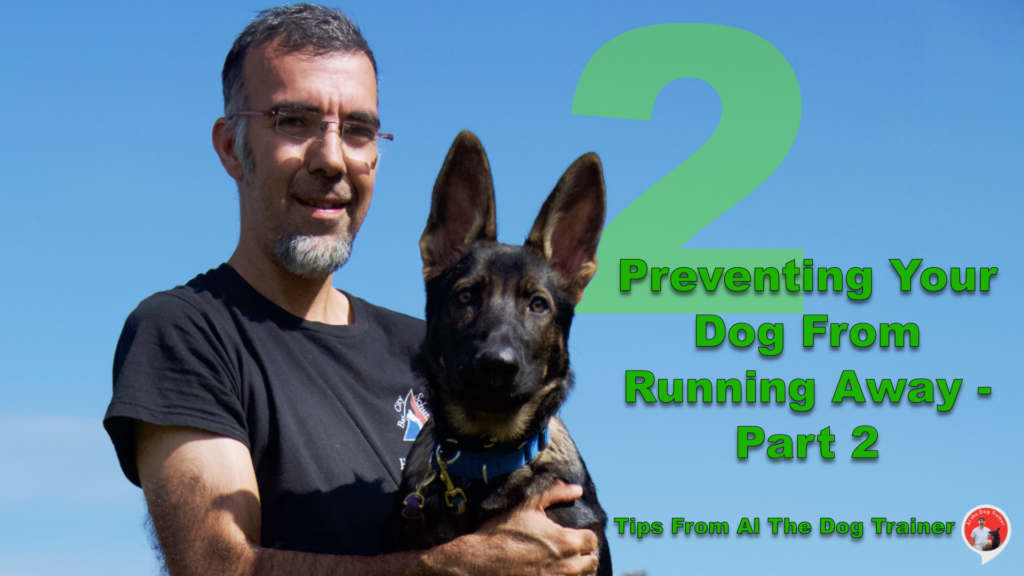
Today’s topic is: Preventing Your Dog From Running Away-Part 2. So on Friday, I covered a way to prevent your dog from running away. I gave the example of showing your dog that there was a difference of consequences if they were to go out the front door without any permission.
So obviously there was a negative consequence for going out the door without permission. And then there should be quite a bit of positive implications for the dog that stays inside. So today, what I wanted to share with you is a method that I use that doesn’t necessarily use an aversive. But it does take some time to develop. This will help your dog from running away.
Potty Behavior
So when I got Alpha and Jericho, I knew that I wanted to change their potty behavior. I wanted their potty behavior to be slightly different from what I was doing with Gabby. Gabby has used the restroom in the backyard and on walks, but primarily in the backyard. I wanted to take Alpha and Jericho out into the front yard for a variety of reasons. One of those reasons is that I want these dogs to understand the different distractions. There are other dogs, other people, cats, and all of that. To see those distractions and to remain neutral.
Both of these dogs were already pretty neutral, to begin with. So what I started doing was I was bringing both dogs out on a long line. As long as they were in the yard, the line was more or less slack. I say more or less because while I was directing them to the specific part of my front yard that I wanted them to use the restroom. Yes, I would lead them by putting some leash pressure and guiding them in the direction I wanted them to move.
But you should understand for this exercise, if you’re trying to prevent your dog from running away, you’ll have a long line, and you’ll let your dog roam about your front yard. But you need to have already an idea of where your yard your neighbor’s yard begins and ends? And most importantly, where does the street begin? In my particular instance, I have a pretty firm curb. I know there’s kind of soft curbs that some homes have. Now I have a reasonably firm curb in front of my house, and I decided to let my dogs know that they weren’t going to be allowed to get any further than that curb.
Deny Them the Ability
So all I did with them was anytime that they would begin to get up to the curb, I would deny them the ability to get into the street until they backed off that pressure and came back into the yard. And I just did that day after day, week after week, month after month. Now, they understand where the boundary is, and I did not have to use an aversive. I didn’t have to use the aversive the way that I know that when stray cats, dogs, or other things are beyond that barrier, the dogs aren’t crossing it. But took me a significant amount of time to be able to do that.
Now, I do want to mention that they’ve come across that barrier a couple of times, but it’s just been a footstep. It hasn’t been anything more than that, as they kind of push those boundaries a little bit. Now, I am working on the recalls. And so, because both of these dogs have fairly excellent recall right now, I’m giving a little bit of leeway at that boundary. Because my street is a little bit quieter, however, if you have a busy street, you may consider the first method that I shared on Friday. Because, well, your dog’s life is at risk. And sometimes, using an aversive can be very beneficial for them to understand a firm boundary there.
Now, I don’t know if I’m going to set a hard boundary there at some point, but it is crossing my mind. I might still even with the training that they have right now. I’ll put a boundary there because I want to keep them safe from the worst of tragedies, like getting your dog hit by a car. I think an aversive is a significant way to help protect your dog from those kinds of mistakes.
Counter Conditioning
Yes, you can do many counter conditioning and teach the dog that a yard is a beautiful place. But I think that if you can do both and do them both well, your dog might be in a better position. So, again, in this technique, a simple long line allows the dogs to have as much range in the yard as possible. But as you get to those boundaries, you begin to put tension down the line, preventing them from crossing the line. And then do that for a relatively significant amount of time compared to the technique I shared before. You are preventing them from making mistakes in the first place.
I hope that was useful for some of you in helping your dogs from running away. Remember, you can always go to my YouTube Channel for helpful videos. Or find more tips like this right here at www.longoriahausdogtraining.com.
Happy Training!





